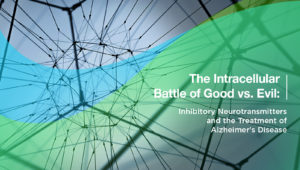
(Credit: Pugo Design Studio)
Neurodegenerative disorders such as Parkinson’s disease and Alzheimer’s disease claim the lives of millions of people each year. But despite all the research being done, very little is known about the mechanisms that are taking place when these diseases are unfolding.
Perhaps even more remarkable, from a pathological point of view, is that the neurons in the brain that die differ with each disease. In Parkinson’s, dopamine-producing cells die off, while in Alzheimer’s, degeneration occurs in the areas of the brain that control higher-level thinking and cognition. Because these diseases result in the death of specific types of brain cells, they are collectively known as selective neurodegenerative diseases.
Intracellular Signaling (aka Detour Ahead)
When I was a graduate student, from 2004 to 2006, I worked in a lab that was interested in studying the intracellular signaling that occurs within these diseases. To understand what intracellular signaling means, think of each cell as an individual machine that receives signals from outside of itself, such as from its environment and other cells. “Intracellular” simply refers to what’s happening within a cell, so intracellular signaling is how the cell gets its commands.
In normal, healthy cells, there are usually numerous different pathways for a signal to travel. Think of it like a cross-country road trip: If you use Waze, you’re probably going to be given a different route than if you use Google Maps, but you’ll still get there. (Although maybe not if you use Apple Maps, but that’s another story.) But when the cells are sick, the signaling is disrupted, meaning those once-reliable interstate routes might be cut off and you could find yourself stuck in a cornfield in Iowa without even knowing which way is west. In some cases, new routes might even open up. Ever heard of Interstate 10X? That might exist in the brain of an Alzheimer’s patient. Those new pathways were what we were trying to map and understand in our research.
Intracellular signaling is such an important concept in traditional biochemistry as a whole that the 2012 Nobel Prize in Chemistry was awarded to two scientists for their lifetime of work related to the topic.
GABA GABA Hey!
I wasn’t trying to win the Nobel Prize when I set out to try to understand the various cell signaling that occurs during a neurodegenerative disorder such as Alzheimer’s disease. I just wanted to see if I could figure out why and how the intracellular signaling was malfunctioning.
More specifically, when it came to Alzheimer’s disease, the core hypotheses of the laboratory where I worked were rooted in three different phenomena:
- Only certain cells (the ones controlling higher-level thinking and cognition) die in the brain of someone with Alzheimer’s disease.
- The concentration of inhibitory neurotransmitters — specifically, gamma-aminobutyric acid (GABA) — was lower in Alzheimer’s disease.
- In some cases of Alzheimer’s disease, the brain was releasing a high amount of inflammatory proteins called cytokines, specifically interleukin-6.
GABA is actually quite important to the nervous system. It’s estimated that 40 percent of your synapses (the space between cells that serves as a pathway) rely on GABA in one way or another. So when GABA-producing cells die off, that intracellular signaling that relies on GABA slows — or dies off altogether.
And in our research of the literature, we saw that GABA concentrations were quite low in people who suffer from Alzheimer’s. Further studies suggested that the high amounts of interleukin-6 were due to low concentrations of GABA. So, we hypothesized, that maybe, just maybe, if we could reduce the presence of the culprit interleukin-6 by introducing GABA, we might be able to eliminate Alzheimer’s — or at least slow progression.
To help you follow along, think of this way:
- GABA = good guy
- Interleukin-6 = bad guy
This miniature battle between good and evil was the subject of a master’s thesis I completed in 2006. The research led us to two conclusions:
- GABA was able to inhibit the release of these excitatory cytokines (aka, our villain, interleukin-6) in our lab model.
- There’s a key protein, p38, that is involved with the intracellular signaling of the release of interleukin-6. Plus, it appears that GABA actually prevents p38 from being activated, which in turn prevents the release of interleuken-6.
Without getting into more a more complex explanation of intracellular signaling, the research suggested that GABA — which you can buy on most any grocery shelf — could provide some therapeutic benefit in treating Alzheimer’s disease because it prevents the release of interleukin-6.
All of that research was published in a 2008 issue of the journal Neuroimmunomodulation. If you’d like to read a bit more, you can also read my thesis.